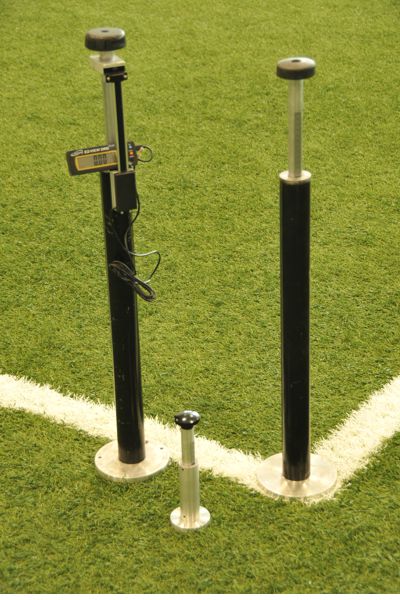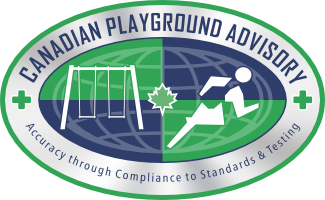Measuring Infill and System Depth ith a 3 Prong Gauge
Measuring Infill and System Depth with a 3 Prong Gauge
Volume 9, Issue 1 April 2019
Infilled synthetic turf systems are typically termed the 3rd generation of synthetic turf and accepted by North American Footfall in the 1990s and Football (soccer) such as UEFA in 2002 as “nearly equivalent to natural turf” for play. Although there are a lot of requirements to the sport specific performance of a turf, and there is much debate over the types of infill, the fact that infill depth will influence the perceived “softness” of a field, the shock absorption and traction or friction of the field cannot be disputed. Installing the infill to the appropriate depth is the responsibility of the system designer and manufacturer with the provision of clear specifications and instructions for the installer to ensure the entire system is installed correctly. Once the system is installed, the owner/operator becomes responsible for the performance of the field through the warranty and to the end of life. Measuring the depth of infill will be a critical measure of the adequacy of the maintenance program.
When the owner/operator takes over the field, the only portion of the system they have any control of will be the infill for depth and compaction. The amount of use and configurations of use will dictate the frequency and importance of measuring. Measuring the depth of infill will indicate that the infill has moved, increased, decreased or become compacted. The measuring of infill depth reveals symptoms of a problem and allows the turf manager to bring the correct remedial action to the problem.
The infill will very rarely be to the absolute top of or above the turf. There will always be a portion of the turf above the infill and this might prevent the baseplate of the depth gauge from contacting the infill and leaving and air gap. Where the turf system is older or laid over this will not be as significant a problem. For those systems where an air gap can be created between the bottom of the depth gauge baseplate and the infill, the baseplate must be placed on the turf and the measuring prongs must be allowed to slide freely to come to rest on the top of the infill. The travel must be recorded and subtracted from the measured infill depth.
The depth gauge must be designed to rest evenly on the turf system and the three prongs must slide freely without assist from the operator. Secondly, once the test prongs have settled on the infill, the operator must be able to push on the center rod, pushing the test prongs down into the infill without disruption of the baseplate and the system. If necessary and when there is significant compaction the test prongs can be pushed to the bottom of the system and the carpet backing. When the test prongs have contacted the turf backing, the reading is taken. If the travel was measured, then this is subtracted from the second measurement taken.
The original three prong depth gauges have been developed to measure the depth of athletic running track surfaces. Since these surfaces are rigid, the diameter of the barrel, size of the baseplate if there is one and the smoothness of the travel of the three test prongs is not critical to the operation of the device. However; for turf, these features are all critical as the turf and infill are malleable. Using the small barrel depth gauge or the single prong gauges will disrupt the infill and provide an inaccurate reading.
Most depth gauges are analog, meaning that the depth reading is done by looking at the vertical scale on the side of the depth gauge. The latest entry to the depth gauge market is the digital where the travel or push is measured and report digitally. The advantage of the digital depth gauge is that where the turf pile allows the test prongs to travel to the top of infill, the zero can be set by the push of the button and then the measurement is the actual depth of infill.
The procedure of measuring depth of infill with a wide baseplate depth gauge would be as follows;
When the owner/operator takes over the field, the only portion of the system they have any control of will be the infill for depth and compaction. The amount of use and configurations of use will dictate the frequency and importance of measuring. Measuring the depth of infill will indicate that the infill has moved, increased, decreased or become compacted. The measuring of infill depth reveals symptoms of a problem and allows the turf manager to bring the correct remedial action to the problem.
The infill will very rarely be to the absolute top of or above the turf. There will always be a portion of the turf above the infill and this might prevent the baseplate of the depth gauge from contacting the infill and leaving and air gap. Where the turf system is older or laid over this will not be as significant a problem. For those systems where an air gap can be created between the bottom of the depth gauge baseplate and the infill, the baseplate must be placed on the turf and the measuring prongs must be allowed to slide freely to come to rest on the top of the infill. The travel must be recorded and subtracted from the measured infill depth.
The depth gauge must be designed to rest evenly on the turf system and the three prongs must slide freely without assist from the operator. Secondly, once the test prongs have settled on the infill, the operator must be able to push on the center rod, pushing the test prongs down into the infill without disruption of the baseplate and the system. If necessary and when there is significant compaction the test prongs can be pushed to the bottom of the system and the carpet backing. When the test prongs have contacted the turf backing, the reading is taken. If the travel was measured, then this is subtracted from the second measurement taken.
The original three prong depth gauges have been developed to measure the depth of athletic running track surfaces. Since these surfaces are rigid, the diameter of the barrel, size of the baseplate if there is one and the smoothness of the travel of the three test prongs is not critical to the operation of the device. However; for turf, these features are all critical as the turf and infill are malleable. Using the small barrel depth gauge or the single prong gauges will disrupt the infill and provide an inaccurate reading.
Most depth gauges are analog, meaning that the depth reading is done by looking at the vertical scale on the side of the depth gauge. The latest entry to the depth gauge market is the digital where the travel or push is measured and report digitally. The advantage of the digital depth gauge is that where the turf pile allows the test prongs to travel to the top of infill, the zero can be set by the push of the button and then the measurement is the actual depth of infill.
The procedure of measuring depth of infill with a wide baseplate depth gauge would be as follows;
Depth gauge preparation
- Remove the depth gauge from the storage case and ensure that it is in working order and that the test prongs move freely within the barrel of the gauge. Silicon lubricants can be used to ensure smooth operation and prevention of corrosion.
- Place the baseplate on a smooth concrete or metal surface and allow the test prongs to contact with the surface and determine that the depth reading is zero. In the case of the digital gauge ensure that the analog reads zero and the digital reading zeros out.
Measuring the infill depth with the digital depth gauge
- Place the baseplate on the surface at the test location and allow it to settle.
- Allow the test prongs to penetrate the air space between the bottom of the baseplate and the top of the infill.
- Zero the digital readout.
- Without putting any pressure on the outside or barrel of the depth gauge, push down on the center piston until the prongs reach the backing of the turf.
- Read and record the measurement on the digital scale.
- The infill depth will be the digital reading.

Measurement of System Depth
For depth gauges that have test prongs that extend longer than 2”, they can be used to penetrate the backing of the turf and through the underlayment to the underlying granular base. By reading the depth of travel, the bottom and the final depth, the operator has the option of reporting the infill depth, the full system depth and the thickness of the underlayment. Only the depth gauges from Canadian Playground Advisory Inc. are capable of this full depth measurement.
Additional depth readings
For the performance of testing of impact attenuation to ASTM F1936 there will be three infill depth measurement with 1 yard of the impact test location. These depth values can be associated with the impact attenuation values at that location and a correlation between depth of infill and g value can be developed.
The owner/operator can expand and improve their inspection and maintenance program by determining as many as 60 additional locations and performing the infill depth measurements and comparing them to depth measurements with knows impact attenuation values. Any significant variations will require attention of the turf manager.



